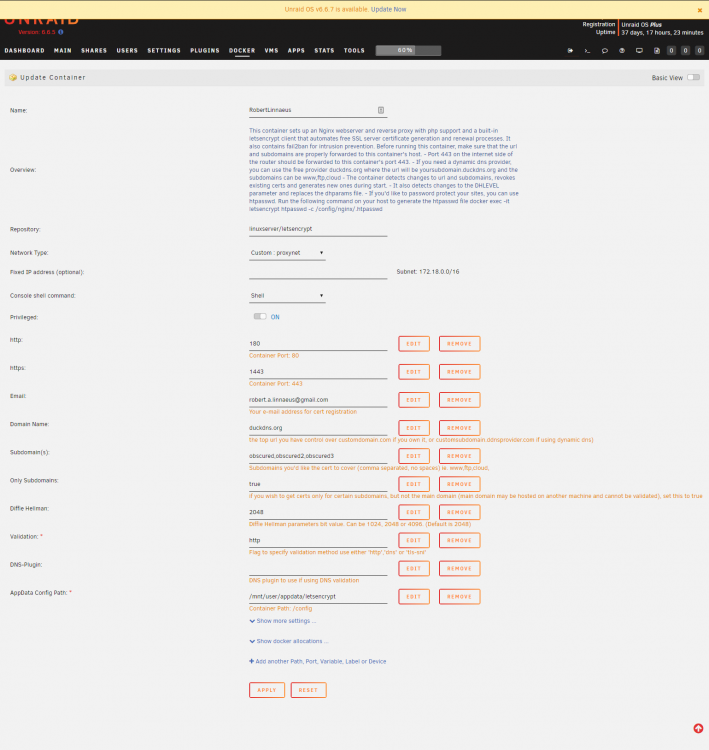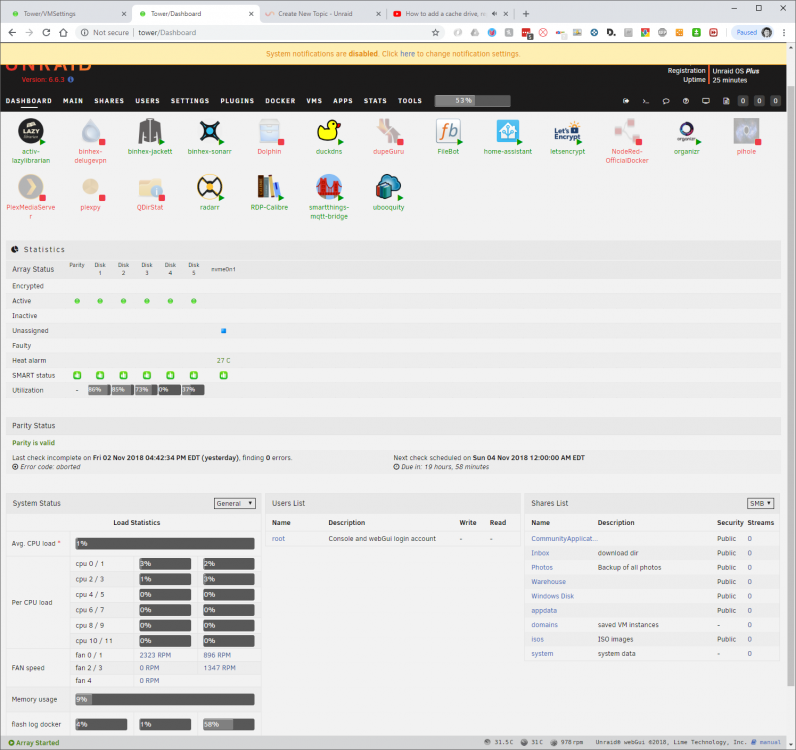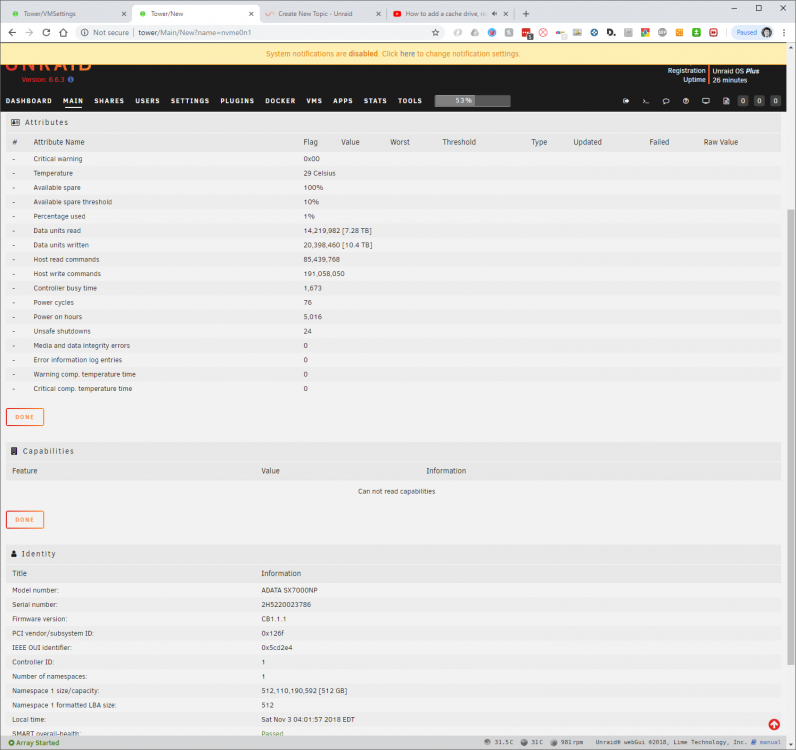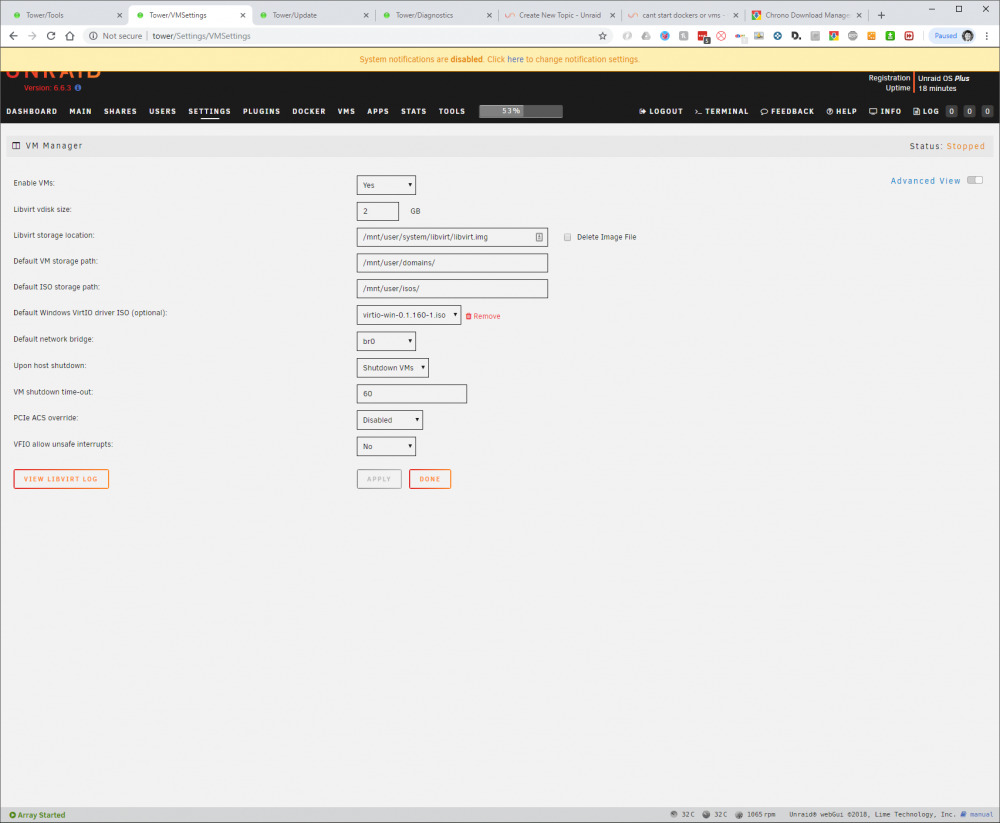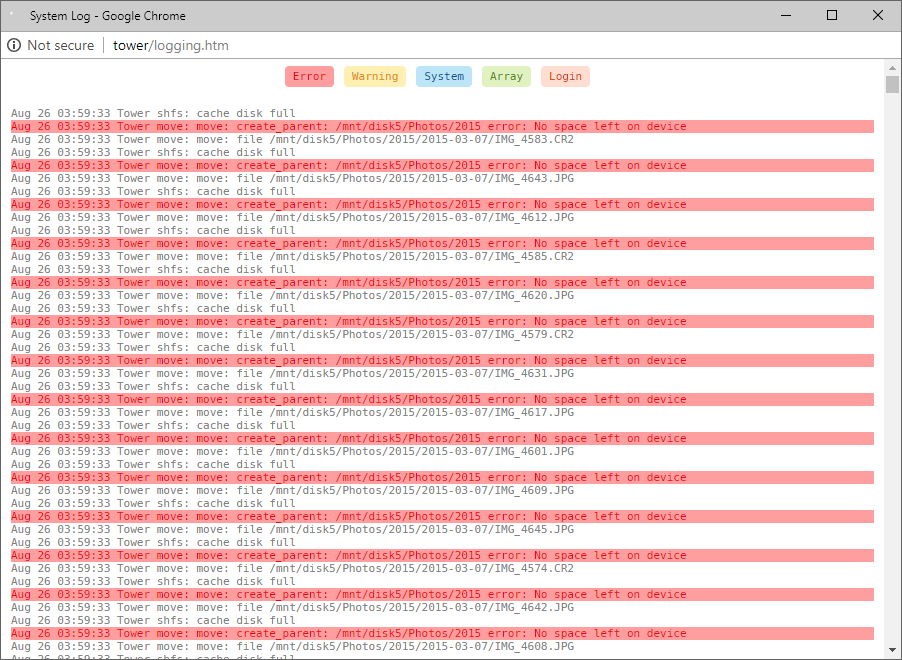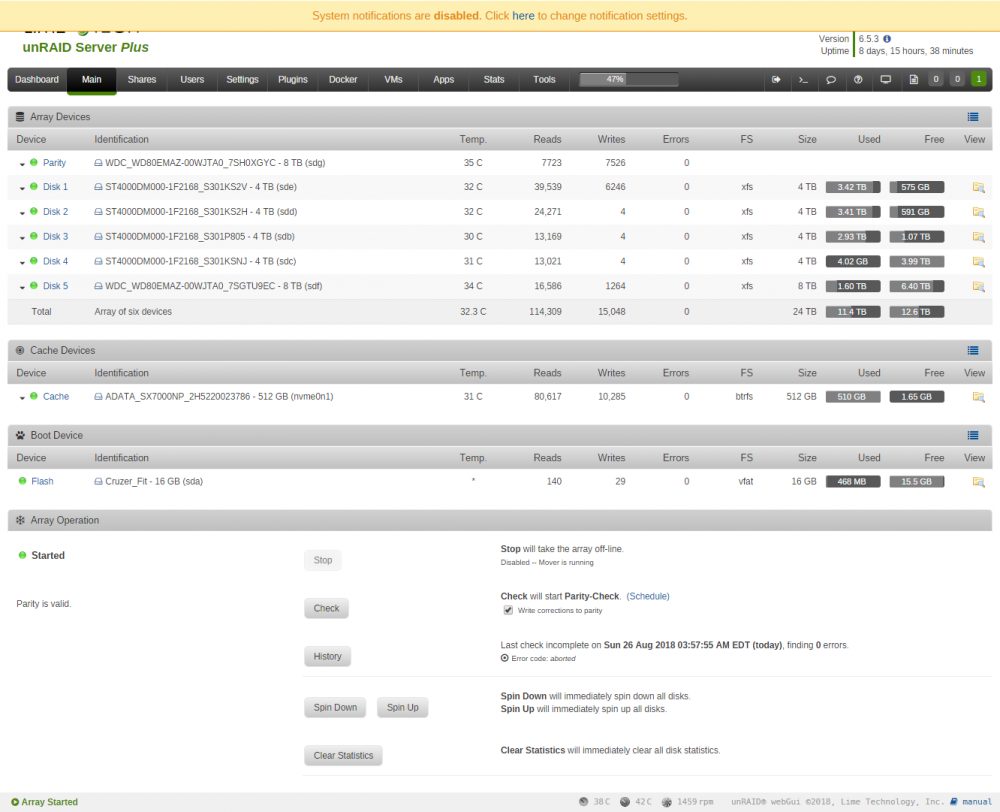
cablecutter
Members-
Posts
55 -
Joined
-
Last visited
Converted
-
Gender
Undisclosed
Recent Profile Visitors
The recent visitors block is disabled and is not being shown to other users.
cablecutter's Achievements
Rookie (2/14)
2
Reputation
-
Q35-3.0 vs i440fx-3.0 for Windows 10 with GPU in 2019?
cablecutter replied to cablecutter's topic in VM Engine (KVM)
For complete-ness, here is my current XML: <?xml version='1.0' encoding='UTF-8'?> <domain type='kvm' id='8'> <name>Windows 10</name> <uuid>15667ac1-2465-fe33-d840-a54b512b265b</uuid> <metadata> <vmtemplate xmlns="unraid" name="Windows 10" icon="windows.png" os="windows10"/> </metadata> <memory unit='KiB'>20971520</memory> <currentMemory unit='KiB'>20971520</currentMemory> <memoryBacking> <nosharepages/> </memoryBacking> <vcpu placement='static'>6</vcpu> <cputune> <vcpupin vcpu='0' cpuset='2'/> <vcpupin vcpu='1' cpuset='3'/> <vcpupin vcpu='2' cpuset='4'/> <vcpupin vcpu='3' cpuset='5'/> <vcpupin vcpu='4' cpuset='8'/> <vcpupin vcpu='5' cpuset='9'/> </cputune> <resource> <partition>/machine</partition> </resource> <os> <type arch='x86_64' machine='pc-i440fx-3.0'>hvm</type> <loader readonly='yes' type='pflash'>/usr/share/qemu/ovmf-x64/OVMF_CODE-pure-efi.fd</loader> <nvram>/etc/libvirt/qemu/nvram/15667ac1-2465-fe33-d840-a54b512b265b_VARS-pure-efi.fd</nvram> </os> <features> <acpi/> <apic/> <hyperv> <relaxed state='on'/> <vapic state='on'/> <spinlocks state='on' retries='8191'/> <vendor_id state='on' value='none'/> </hyperv> </features> <cpu mode='host-passthrough' check='none'> <topology sockets='1' cores='6' threads='1'/> </cpu> <clock offset='localtime'> <timer name='hypervclock' present='yes'/> <timer name='hpet' present='no'/> </clock> <on_poweroff>destroy</on_poweroff> <on_reboot>restart</on_reboot> <on_crash>restart</on_crash> <devices> <emulator>/usr/local/sbin/qemu</emulator> <disk type='file' device='disk'> <driver name='qemu' type='raw' cache='writeback'/> <source file='/mnt/user/domains/Windows 10/vdisk1.img'/> <backingStore/> <target dev='hdc' bus='virtio'/> <boot order='1'/> <alias name='virtio-disk2'/> <address type='pci' domain='0x0000' bus='0x00' slot='0x04' function='0x0'/> </disk> <disk type='file' device='cdrom'> <driver name='qemu' type='raw'/> <source file='/mnt/user/isos/Windows_10_x64.iso'/> <backingStore/> <target dev='hda' bus='ide'/> <readonly/> <boot order='2'/> <alias name='ide0-0-0'/> <address type='drive' controller='0' bus='0' target='0' unit='0'/> </disk> <disk type='file' device='cdrom'> <driver name='qemu' type='raw'/> <source file='/mnt/user/isos/virtio-win-0.1.141-1.iso'/> <backingStore/> <target dev='hdb' bus='ide'/> <readonly/> <alias name='ide0-0-1'/> <address type='drive' controller='0' bus='0' target='0' unit='1'/> </disk> <controller type='usb' index='0' model='qemu-xhci' ports='15'> <alias name='usb'/> <address type='pci' domain='0x0000' bus='0x00' slot='0x07' function='0x0'/> </controller> <controller type='pci' index='0' model='pci-root'> <alias name='pci.0'/> </controller> <controller type='ide' index='0'> <alias name='ide'/> <address type='pci' domain='0x0000' bus='0x00' slot='0x01' function='0x1'/> </controller> <controller type='virtio-serial' index='0'> <alias name='virtio-serial0'/> <address type='pci' domain='0x0000' bus='0x00' slot='0x03' function='0x0'/> </controller> <interface type='bridge'> <mac address='52:54:00:4e:e0:7e'/> <source bridge='br0'/> <target dev='vnet0'/> <model type='virtio'/> <alias name='net0'/> <address type='pci' domain='0x0000' bus='0x00' slot='0x02' function='0x0'/> </interface> <serial type='pty'> <source path='/dev/pts/0'/> <target type='isa-serial' port='0'> <model name='isa-serial'/> </target> <alias name='serial0'/> </serial> <console type='pty' tty='/dev/pts/0'> <source path='/dev/pts/0'/> <target type='serial' port='0'/> <alias name='serial0'/> </console> <channel type='unix'> <source mode='bind' path='/var/lib/libvirt/qemu/channel/target/domain-8-Windows 10/org.qemu.guest_agent.0'/> <target type='virtio' name='org.qemu.guest_agent.0' state='disconnected'/> <alias name='channel0'/> <address type='virtio-serial' controller='0' bus='0' port='1'/> </channel> <input type='mouse' bus='ps2'> <alias name='input0'/> </input> <input type='keyboard' bus='ps2'> <alias name='input1'/> </input> <hostdev mode='subsystem' type='pci' managed='yes'> <driver name='vfio'/> <source> <address domain='0x0000' bus='0x2d' slot='0x00' function='0x0'/> </source> <alias name='hostdev0'/> <rom file='/mnt/user/isos/Zotac.GTX1070Ti.PATCHED.rom'/> <address type='pci' domain='0x0000' bus='0x00' slot='0x05' function='0x0'/> </hostdev> <hostdev mode='subsystem' type='pci' managed='yes'> <driver name='vfio'/> <source> <address domain='0x0000' bus='0x2d' slot='0x00' function='0x1'/> </source> <alias name='hostdev1'/> <address type='pci' domain='0x0000' bus='0x00' slot='0x06' function='0x0'/> </hostdev> <memballoon model='none'/> </devices> <seclabel type='dynamic' model='dac' relabel='yes'> <label>+0:+100</label> <imagelabel>+0:+100</imagelabel> </seclabel> </domain> -
Q35-3.0 vs i440fx-3.0 for Windows 10 with GPU in 2019?
cablecutter posted a topic in VM Engine (KVM)
Hi All, I've had a windows 10 VM running on my machine now for the past couple years. It has a Ryzen 1700 and a NVIDIA 1070 passed through and has been working...ok... Recently I've turned it into a render slave for houdini/redshift and have noticed some instability. Namely, it will crash (and crash unraid) when running heavy CPU/GPU/RAM activities. One thing that I'm exercising in particular is the amount of data I'm pushing from system ram to the GPU ram. I'm assuming that this is really heavy on the PCI-E lanes...which made me think. I'm currently using the 1440-fx-3.0 machine type - originally when I set this up I could not get pass-through working with Q35. But...from what I understand, Q35 has better support for native PCI-E whereas 1440-fx is doing some kind of emulation. It would seem that for rendering VIA GPU, unhindered PCIE would be best. Now we're several versions down the line and I'm wondering if people are using Q35 for windows 10 gaming PC's? Also, is it possible to convert a VM from one machine type to another without starting fresh? Much thanks, Rob -
2048 bit DH parameters present SUBDOMAINS entered, processing SUBDOMAINS entered, processing Only subdomains, no URL in cert Sub-domains processed are: -d XXXXXX.duckdns.org -d XXXXXXX.duckdns.org -d XXXXXXXX.duckdns.org E-mail address entered: [email protected] http validation is selected Generating new certificate Saving debug log to /var/log/letsencrypt/letsencrypt.log Plugins selected: Authenticator standalone, Installer None Obtaining a new certificate An unexpected error occurred: There were too many requests of a given type :: Error creating new order :: too many certificates already issued for exact set of domains: linnaeus.duckdns.org,linnio.duckdns.org,lserv.duckdns.org: see https://letsencrypt.org/docs/rate-limits/ Please see the logfiles in /var/log/letsencrypt for more details. ERROR: Cert does not exist! Please see the validation error above. The issue may be due to incorrect dns or port forwarding settings. Please fix your settings and recreate the container
-
Hi all, Having an odd issue at container startup "Can't open privkey.pem for reading, No such file or directory". However, the keys are saved in the folder specified and the privileges for the files should allow letsencrypt to access them (even tried 777). Any help would be appreciated. - Congratulations! Your certificate and chain have been saved at: /etc/letsencrypt/live/XXXXXXX.duckdns.org-0001/fullchain.pem Your key file has been saved at: /etc/letsencrypt/live/XXXXXXX.duckdns.org-0001/privkey.pem Your cert will expire on 2019-06-05. To obtain a new or tweaked version of this certificate in the future, simply run certbot again. To non-interactively renew *all* of your certificates, run "certbot renew" - If you like Certbot, please consider supporting our work by: Donating to ISRG / Let's Encrypt: https://letsencrypt.org/donate Donating to EFF: https://eff.org/donate-le Can't open privkey.pem for reading, No such file or directory 22760616274792:error:02001002:system library:fopen:No such file or directory:crypto/bio/bss_file.c:72:fopen('privkey.pem','r') 22760616274792:error:2006D080:BIO routines:BIO_new_file:no such file:crypto/bio/bss_file.c:79: unable to load private key cat: privkey.pem: No such file or directory cat: fullchain.pem: No such file or directory New certificate generated; starting nginx [cont-init.d] 50-config: exited 0. [cont-init.d] done. [services.d] starting services cat: privkey.pem: No such file or directory cat: fullchain.pem: No such file or directory New certificate generated; starting nginx [cont-init.d] 50-config: exited 0. [cont-init.d] done. [services.d] starting services [services.d] done. Server ready Edit: After fiddling a bit the problem continues and now I cannot get new certs. ... Plugins selected: Authenticator standalone, Installer None Renewing an existing certificate An unexpected error occurred: There were too many requests of a given type :: Error finalizing order :: too many certificates already issued for exact set of domains: XXXXXXX.duckdns.org,linnio.duckdns.org,lserv.duckdns.org: see https://letsencrypt.org/docs/rate-limits/ Please see the logfiles in /var/log/letsencrypt for more details. Can't open privkey.pem for reading, No such file or directory 23291569253224:error:02001002:system library:fopen:No such file or directory:crypto/bio/bss_file.c:72:fopen('privkey.pem','r') 23291569253224:error:2006D080:BIO routines:BIO_new_file:no such file:crypto/bio/bss_file.c:79: unable to load private key cat: privkey.pem: No such file or directory cat: fullchain.pem: No such file or directory New certificate generated; starting nginx [cont-init.d] 50-config: exited 0. [cont-init.d] done. [services.d] starting services nginx: [emerg] BIO_new_file("/config/keys/letsencrypt/fullchain.pem") failed (SSL: error:02001002:system library:fopen:No such file or directory:fopen('/config/keys/letsencrypt/fullchain.pem','r') error:2006D080:BIO routines:BIO_new_file:no such file) [services.d] done. Server ready Server ready nginx: [emerg] BIO_new_file("/config/keys/letsencrypt/fullchain.pem") failed (SSL: error:02001002:system library:fopen:No such file or directory:fopen('/config/keys/letsencrypt/fullchain.pem','r') error:2006D080:BIO routines:BIO_new_file:no such file) nginx: [emerg] BIO_new_file("/config/keys/letsencrypt/fullchain.pem") failed (SSL: error:02001002:system library:fopen:No such file or directory:fopen('/config/keys/letsencrypt/fullchain.pem','r') error:2006D080:BIO routines:BIO_new_file:no such file) nginx: [emerg] BIO_new_file("/config/keys/letsencrypt/fullchain.pem") failed (SSL: error:02001002:system library:fopen:No such file or directory:fopen('/config/keys/letsencrypt/fullchain.pem','r') error:2006D080:BIO routines:BIO_new_file:no such file)
-
[support] Spants - NodeRed, MQTT, Dashing, couchDB
cablecutter replied to spants's topic in Docker Containers
Thanks Spants - I'm kind of a newbie when it comes to Docker. All I do is click install on the community apps - haven't really dug much deeper than that. Is there any info you could provide on editing the template itself for use with unRaid? I'd also love to build a docker version of Hass.IO for unraid. I'm currently doing a very stupid work-around of running it on a linux VM on my unraid server. -
[support] Spants - NodeRed, MQTT, Dashing, couchDB
cablecutter replied to spants's topic in Docker Containers
Hey, having an issue with the Node-Red: https://github.com/AYapejian/node-red-contrib-home-assistant/issues/52 Looks like the newest version of Node-Red needs node.js > V8 I just checked and it seems like this docker is packed with v6.14.4 -
Cache drive "unassigned" after unsafe shutdown (power loss)
cablecutter replied to cablecutter's topic in General Support
Well... I stopped the array and added the cache drive back in. Everything seems to be working fine. Still not sure why this happened, was quite scary. -
Hi all, My server has been running for months in its current configuration. I have a cache drive that is used for shuffling files and storing VM's. Unfortunately, after an unsafe shutdown yesterday (I knocked a power strip by accident) I noticed that the VM's failed to start on boot. I initially was troubleshooting this as a KVM issue, but noticed this morning that the cache drive is "Unassigned" and therefore all of the shares on that drive are showing as "empty". I don't want to lose my VM's - really don't have the time to set this all up again. How can I fix this? How can I add my cache drive back into the array without losing any data / mapping of shares? Best, Rob tower-diagnostics-20181103-0342.zip
-
Hi All, Recently had an unclean shutdown - just tapped off the power switch by accident. After rebooting the two vm's I have set up (windows and linux) were missing. When I stopped and started the VM service it failed to start, giving the error "Libvirt Service failed to start." I am pointing to the proper ISOs folder, domains folder, and libvert image directly. I am running 6.6.3 but was running 6.6.1 when it happened. I have tried rebooting the box. On fresh boot it will show th VM's tab with no images. On restarting the VM service I will receive the error noted above. tower-diagnostics-20181102-1656.zip
-
Hi All, Having an odd error with my mover. Noticed a while back that transfers were slowing down. When I checked my cache disk I saw that it was full. I turned on logs for the mover and ran it to find this error. Not really sure how to address this. Disk5 has free space, and the photos share has 12.6TB free. Photos share is set to use cache = "yes'. The cache has 2gb free. Mover log: Main Dash:

